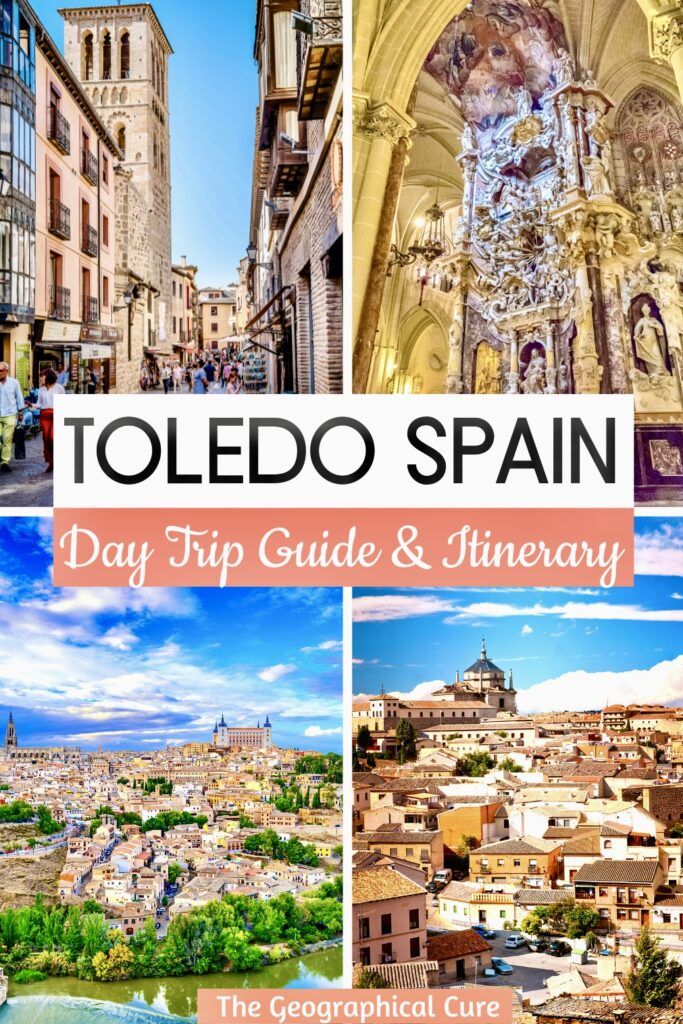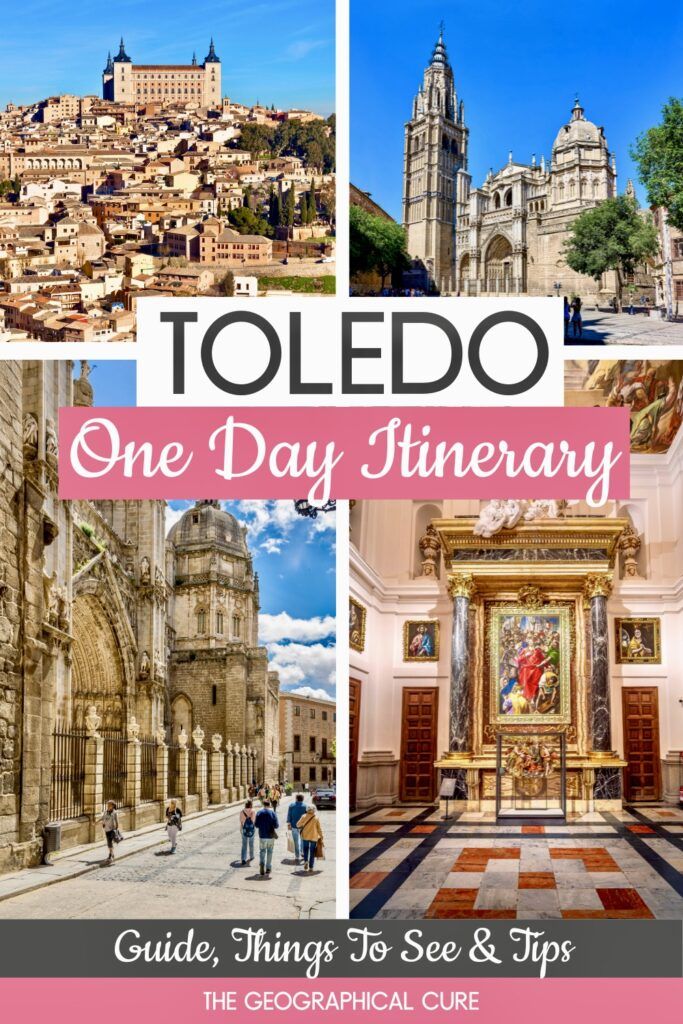Toledo is one of Spain’s great historic cities. It’s romantic too, spectacularly sited on a hilltop atop the Tagus River. The river wraps around it like a moat.
Toledo boasts incredibly well-preserved medieval architecture, a rich cultural heritage, and stunning vistas. It’s dubbed the “City of Three Cultures” for its Christian, Muslim, and Jewish influences.
The city has echos of El Greco, its most famous native son, that will thrill art lovers. Besides that, the entire place is a designated UNESCO site and is well worth a visit.
Toledo is just a short 30 minute train ride from Madrid. So, it’s a classic — and popular! –day trip destination. This itinerary features the city’s greatest hits to help you make the most of your one day in Toledo.
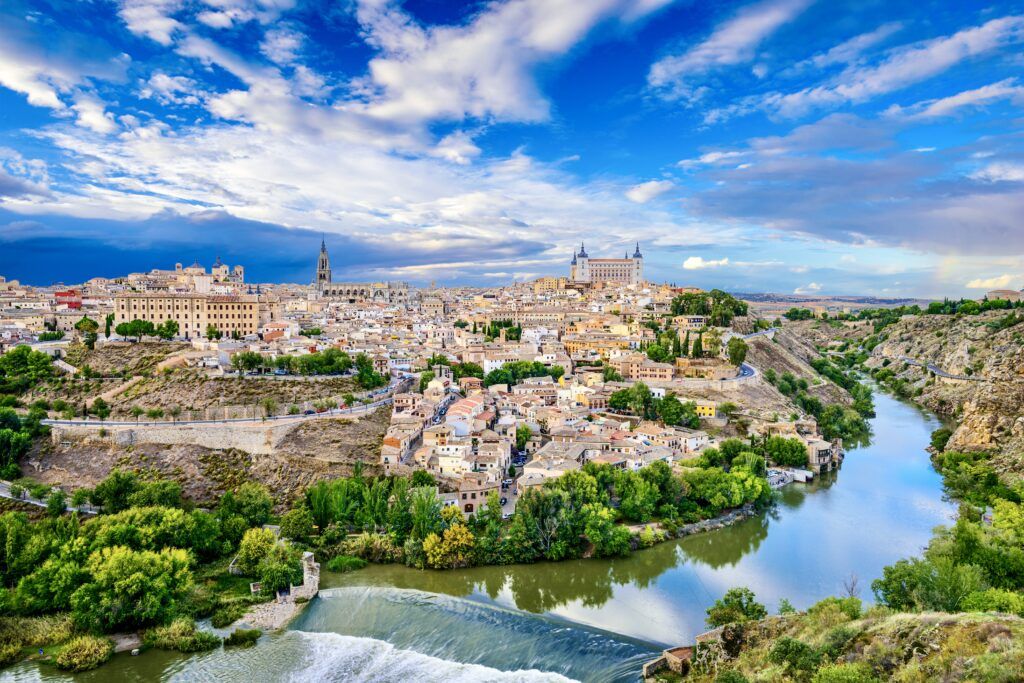
Overview of One Day In Toledo Itinerary
Here’s a snapshot of what you can see in Toledo:
- Historic Center
- Santa Cruz Museum
- Toledo Cathedral
- San Roman & Santo Domingo el Antiguo
- Jewish Quarter
- Santo Tomé Church
- El Greco Museum
- Mirador del Valle
You can add or subtract things based on your pace of travel. And I give you an estimated timeline for how to spend your day.
I advise getting to Toledo as early as possible, as there are so many things to see and do. If you make a late start, you’ll likely regret not having a few more hours to sightsee.
The biggies to see are Toledo Cathedral, the synagogues, the Santa Cruz Museum, and the El Greco Museum. To skip the lines at the main monuments, you may want to pre-book the Toledo Wristband.
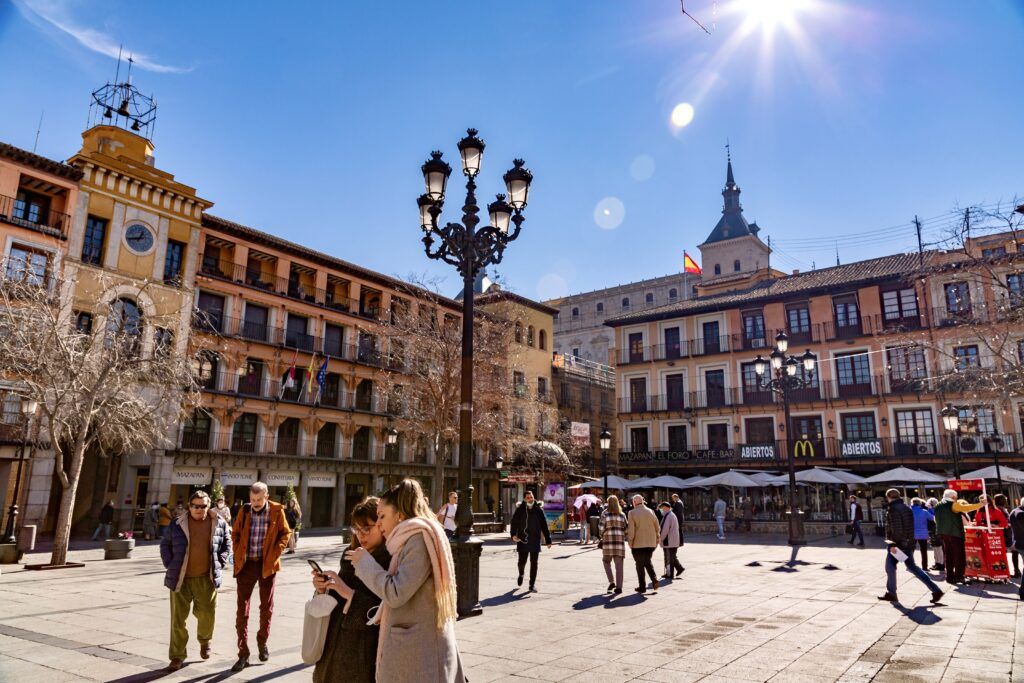
9:00 AM: Historic Center
Begin your day with a delicious Spanish snack in Toledo’s charming Old Town. It’s incredibly well-preserved, with tiny medieval streets.
You’ll find cozy cafes and bakeries where you can savor traditional pastries, like churros or pulgas, paired with a strong cup of coffee.
Take a wander through the main squares — Plaza Zocodover, Plaza de la Magdalena, and Plaza de Santo Domingo el Antiguo.
Zocodover is the main square. The name derives from the Arab word for livestock markets.
This square was once the scene of bullfights and Inquisition judgments. You can plop down on one of the benches, decorated with colorful tiled scenes from Cervantes’ Don Quixote.
>>> Click here to book a guided walking tour
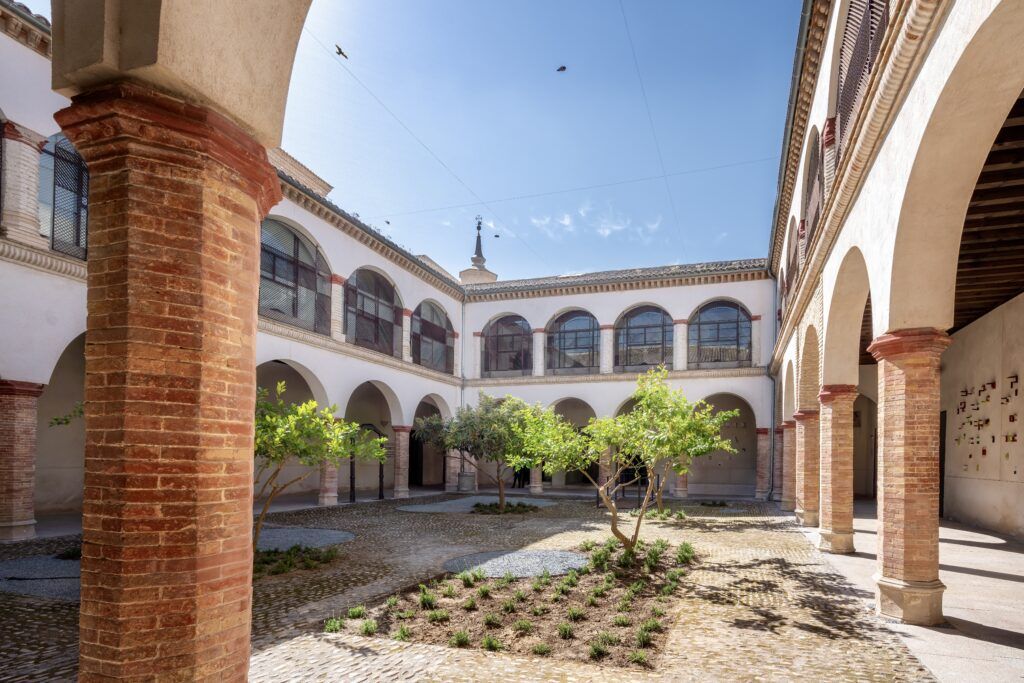
10:00 AM: Santa Cruz Museum
Start your sightseeing with the Santa Cruz Museum. Your GPS likely won’t get you there. Go through the horseshoe arch and head down the stairs.
To the right, you’ll come across one of Toledo’s most stunning Spanish Renaissance structures, the Hospital y Museo de Santa Cruz.
Established in the 16th century by Cardinal Mendoza, a significant figure in Spanish history, the hospital had a dual mission of providing medical care to those in need and offering refuge to orphans.
The building boasts an intricately carved facade, lovely cloisters, and a remarkable staircase, all designed by Alonso de Covarrubias in the plateresque style.
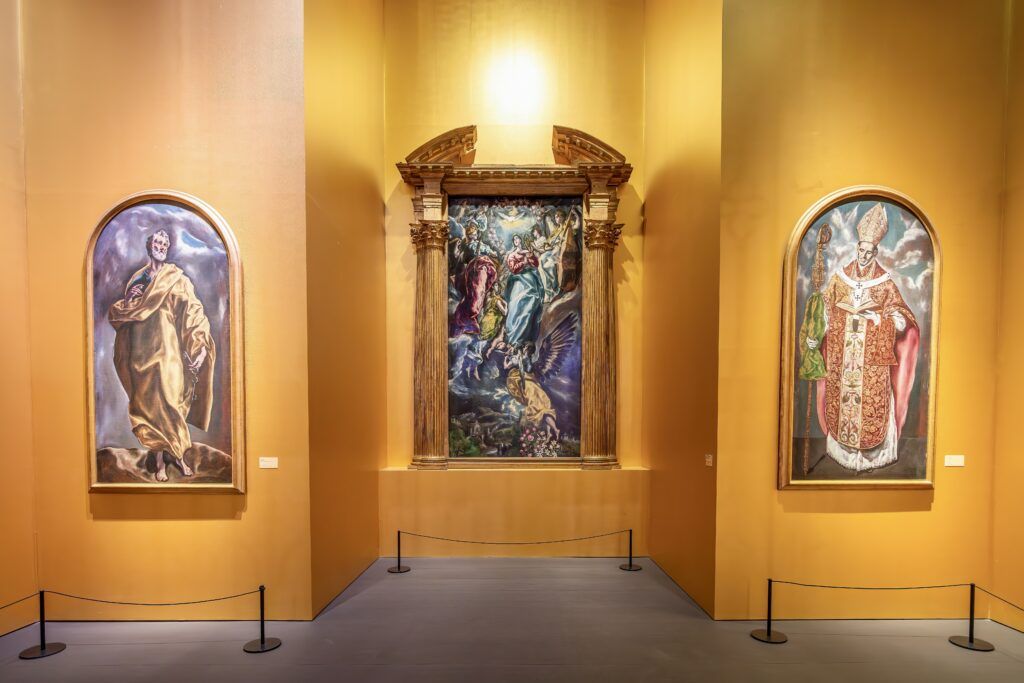
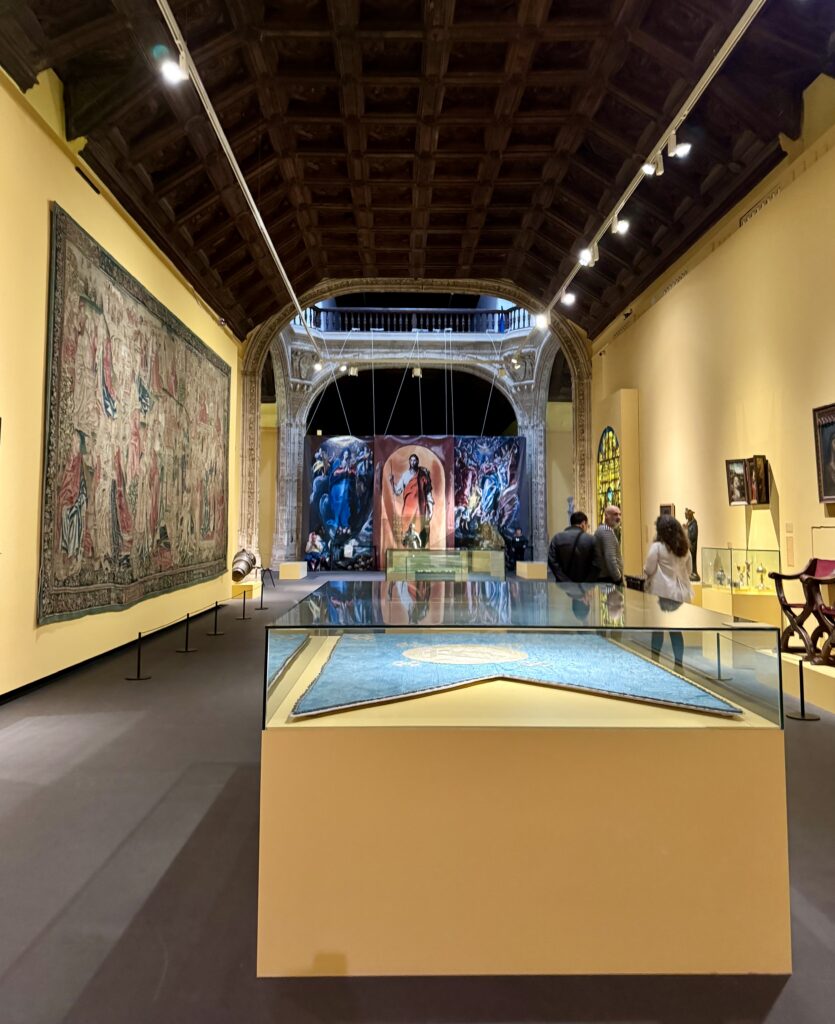
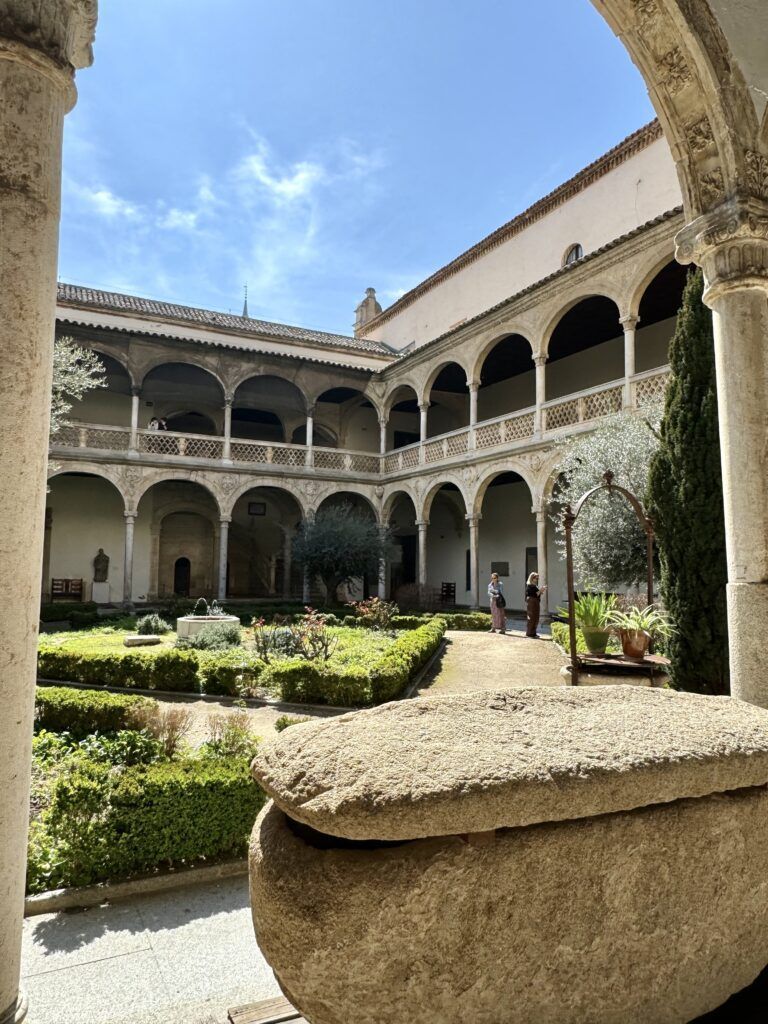
The hospital now houses Toledo’s main museum of art and archaeology.
There are three spaces to see — the Renaissance cloister, the temporary exhibition hall (in the basement), and the bulk of the collection in the second floor galleries with works from the Paleolithic era to the present.
There are also Roman mosaics, sculptures, tapestries, and giant tusks of a Paleolithic mammal.
The final hall displays 16th century Renaissance artworks.
There are a dozen or so El Greco paintings, including The Assumption of the Virgin, The Immaculate Conception, and The Holy Family. The Assumption is one of El Greco’s masterpieces from his late period.
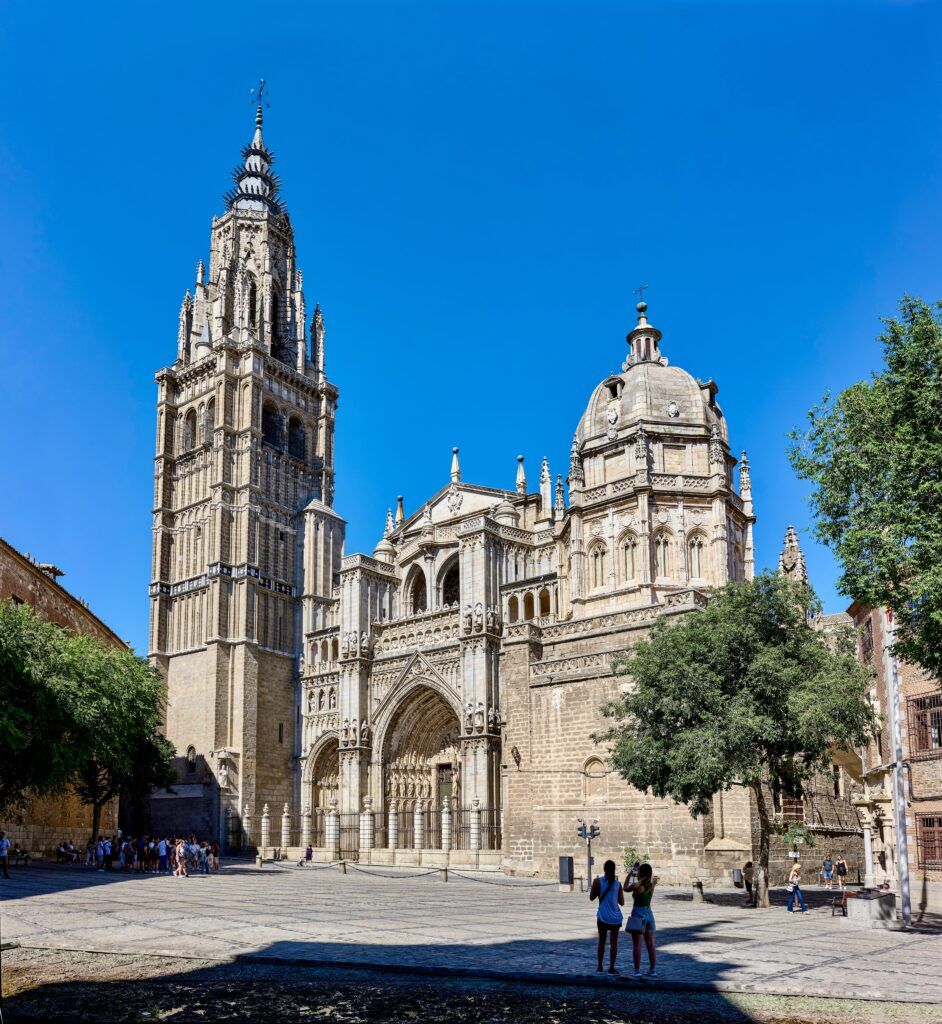
11:00 PM: Toledo Cathedral
Next, head to Toledo Cathedral, the city’s #1 attraction. It’s an extraordinary church that’s a masterpiece of Gothic architecture and a mini art museum. Construction began in 1226, but it took 270 years to complete.
Start off by marveling at its intricate facade. The western portal has three heavily sculptured doors in the Moorish style. and a (partially obscured) rose window. The doors are only opened on special occasions.
There’s a Flamboyant Gothic spire to the left. To the right is a Baroque dome added by El Greco’s son, Jorge Manuel.
Inside, you’ll find an art-filled space filled with works by El Greco and other Spanish masters.
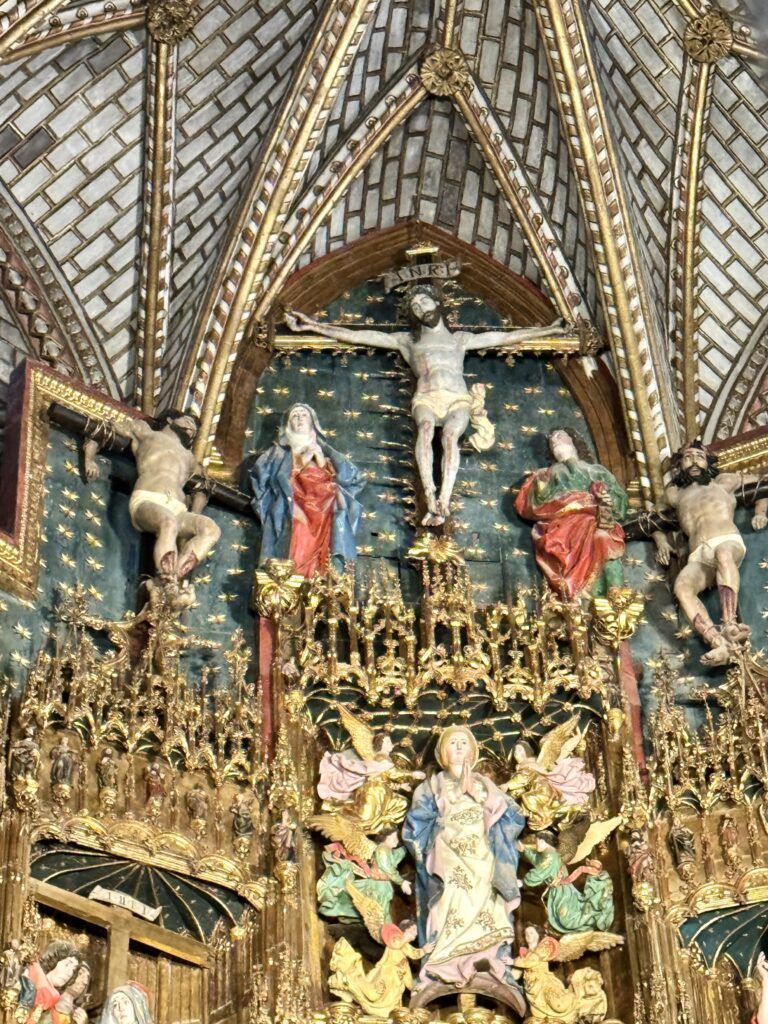
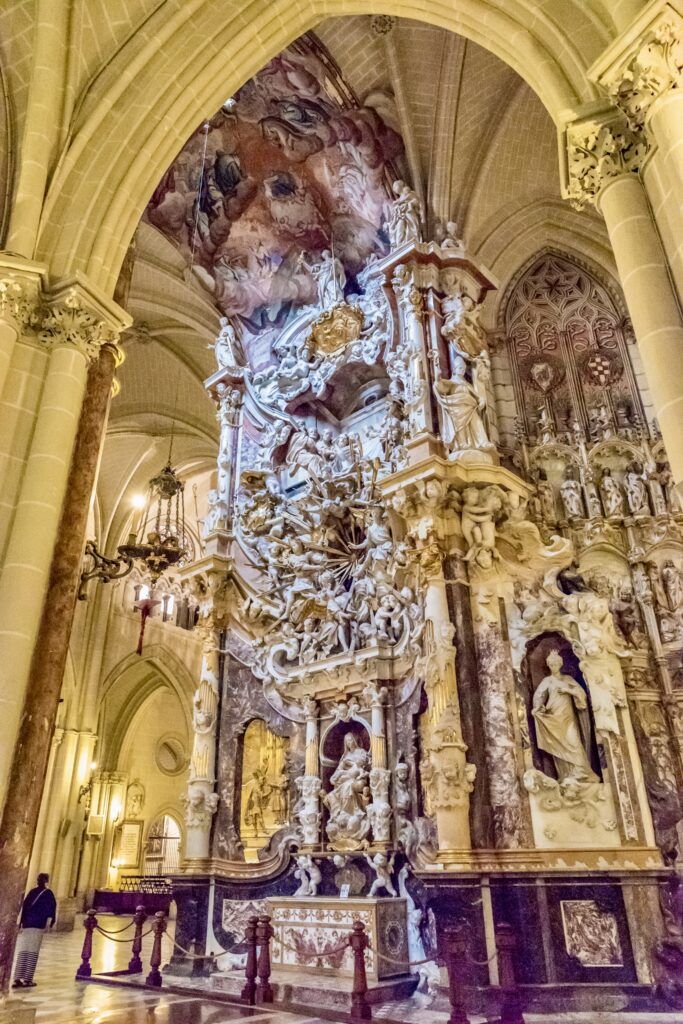
You enter the cathedral from a side entrance, Puerta Llana, on Calle Cisneros. You buy a ticket from the shop opposite the entrance. You can also book a guided tour to see it all.
Inside, there is lofty ribbed vaulting and 800 stained glass windows. The wooden choir stalls are masterpieces from the 15th century.
The main altar is a gigantic Flamboyant Gothic polychrome carving. It’s gold on wood. It depicts the story of Christ’s life, conveying the message of salvation.
The choir stalls are absolutely exquisite. The lower stalls are made of walnut. Animal carvings depict the vices and virtues of mankind. The upper stalls feature alabaster prophets and saints and apostles carved in wood.
The two enormous organs, one Baroque and one Neoclassical, are still used. Each has over 600 pipes.
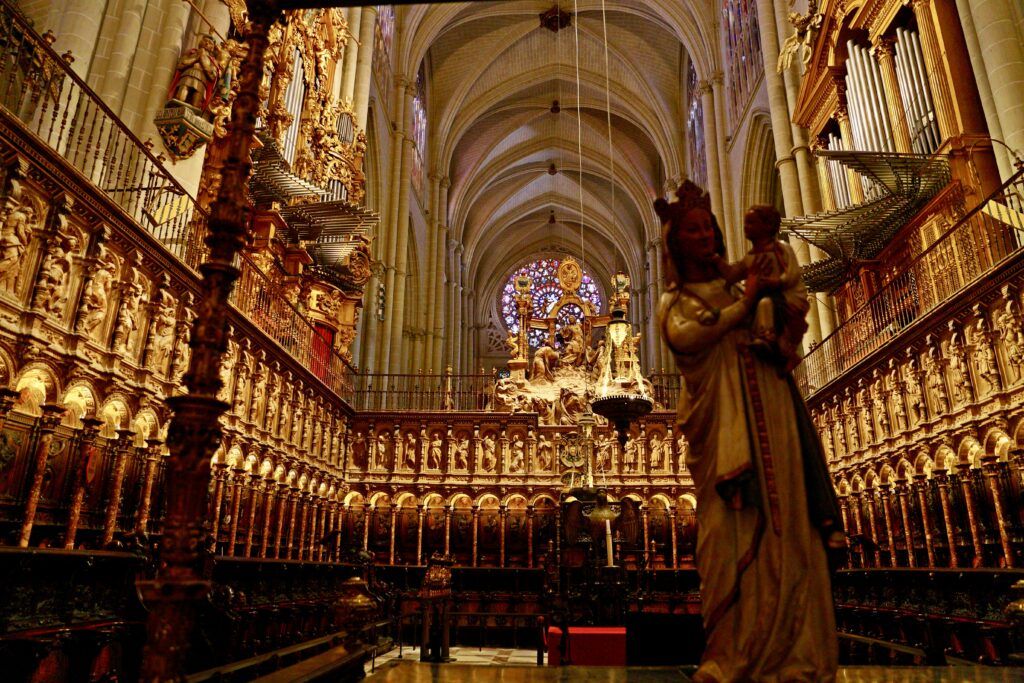
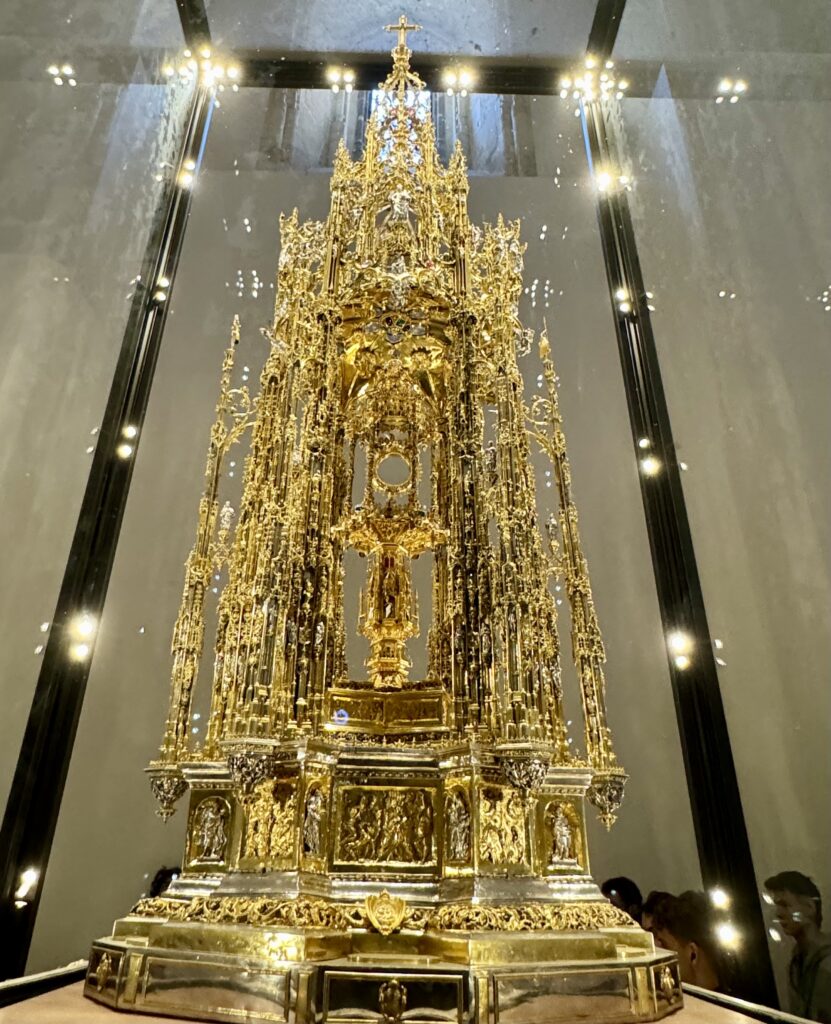
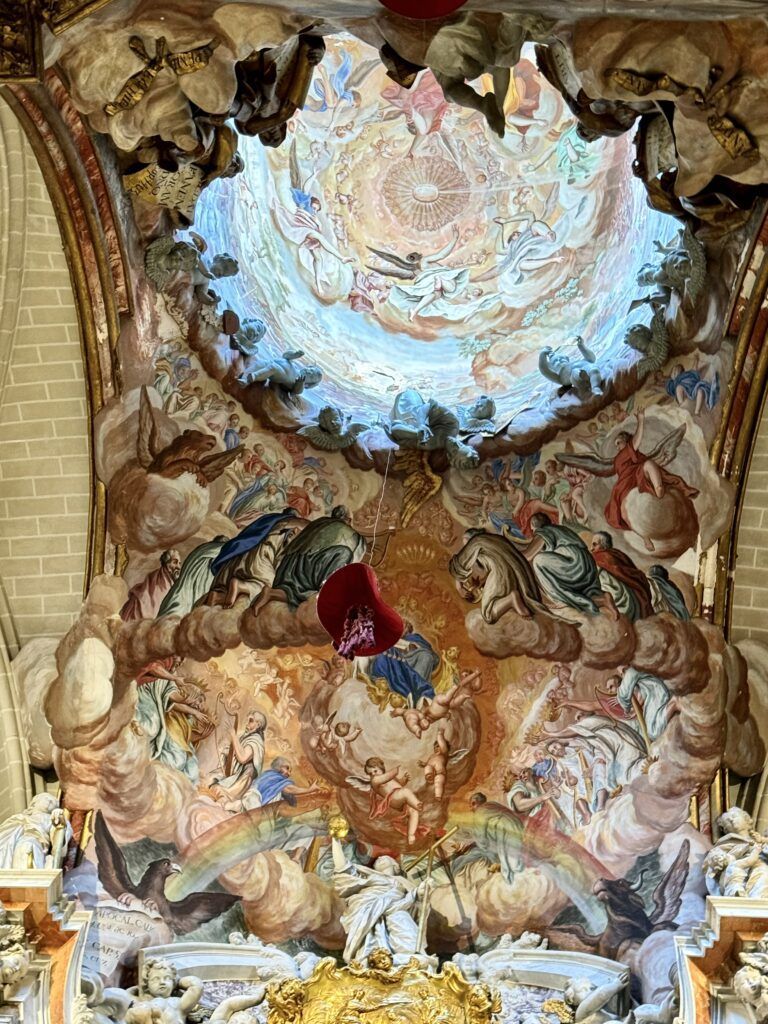
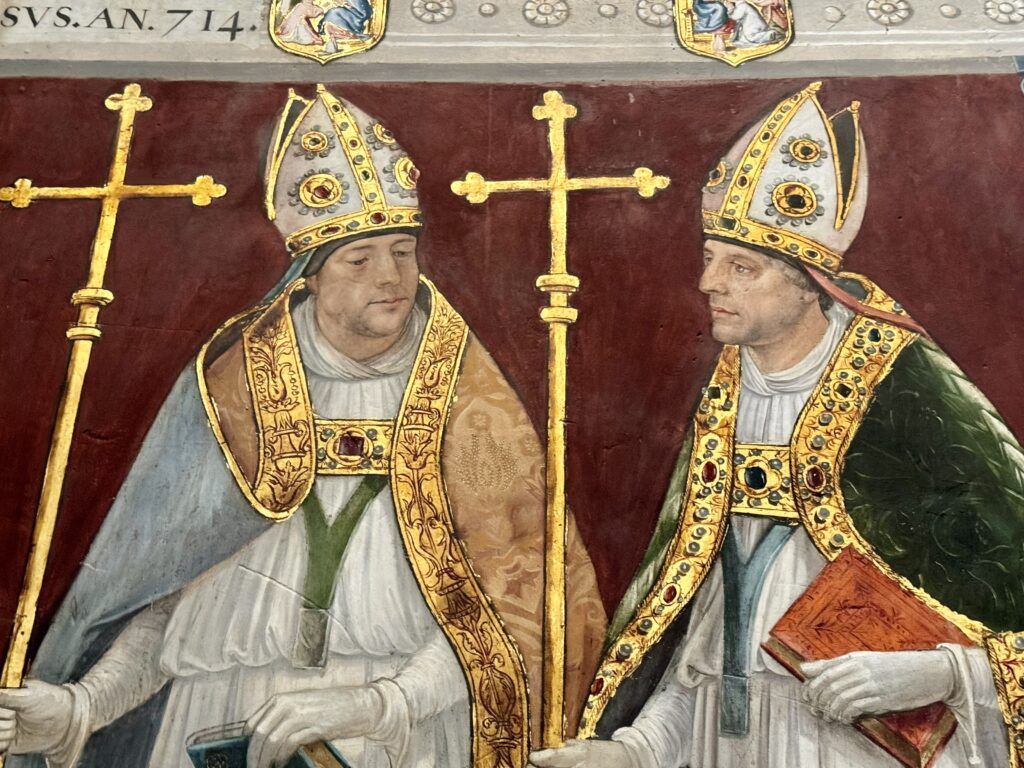
In the main chapel, just opposite the choir, you’ll find a Baroque folly called the Transparente from 1732. It’s unique architectural feature designed by the Spanish architect Narciso Tomé in the 18th century.
A skylight above allows light to penetrate from the ceiling and illuminate the tabernacle. Below the skylight is a sculpted tableau that represents the Ascension of Christ.
To the right is the exquisite Chapter House. It features magnificent coffered ceilings, one with gold leaf. There is a double row of portraits of Toledo’s most powerful archbishops, some from the imagination and some from life.
Frescos on the sides depict scenes from the life of the Virgin Mary. Above is an ornate coffered ceiling.
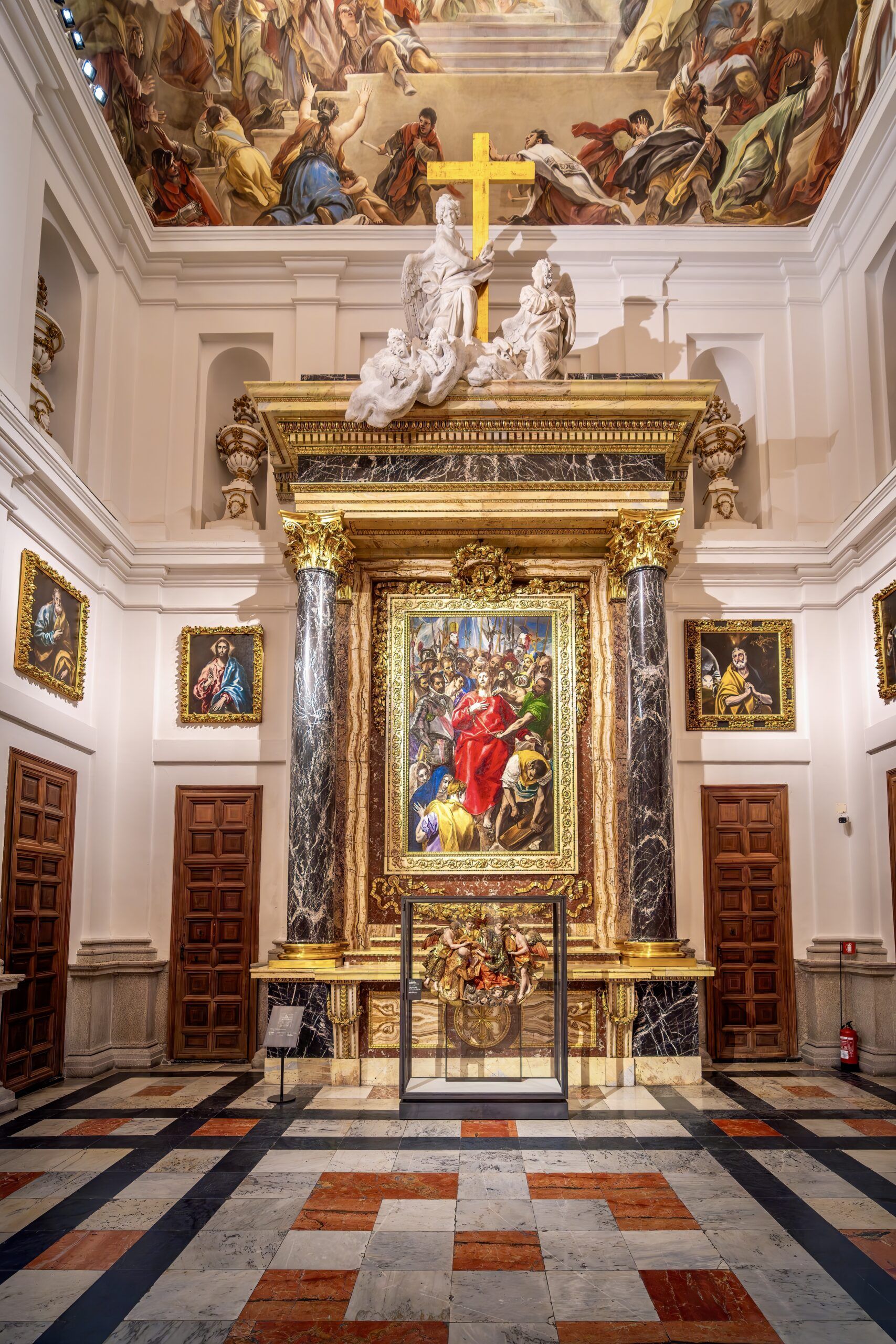
For art lovers, the highlight of the cathedral is the sacristy. This is an art gallery in itself.
There are restored works by El Greco, Zubbaran, and Goya. And an elaborate ceiling fresco by Luca Giordano, The Descent of the Virgin.
The showstopper is El Greco’s Disrobing of Christ, Il Expolio. It depicts the moment when Jesus was undressed before being crucified.
The painting is an early work by El Greco. It’s very Italian, reflecting the artist’s tenure in Venice where he was influenced by artists like Titian. (Note the bright red color of the robe.)
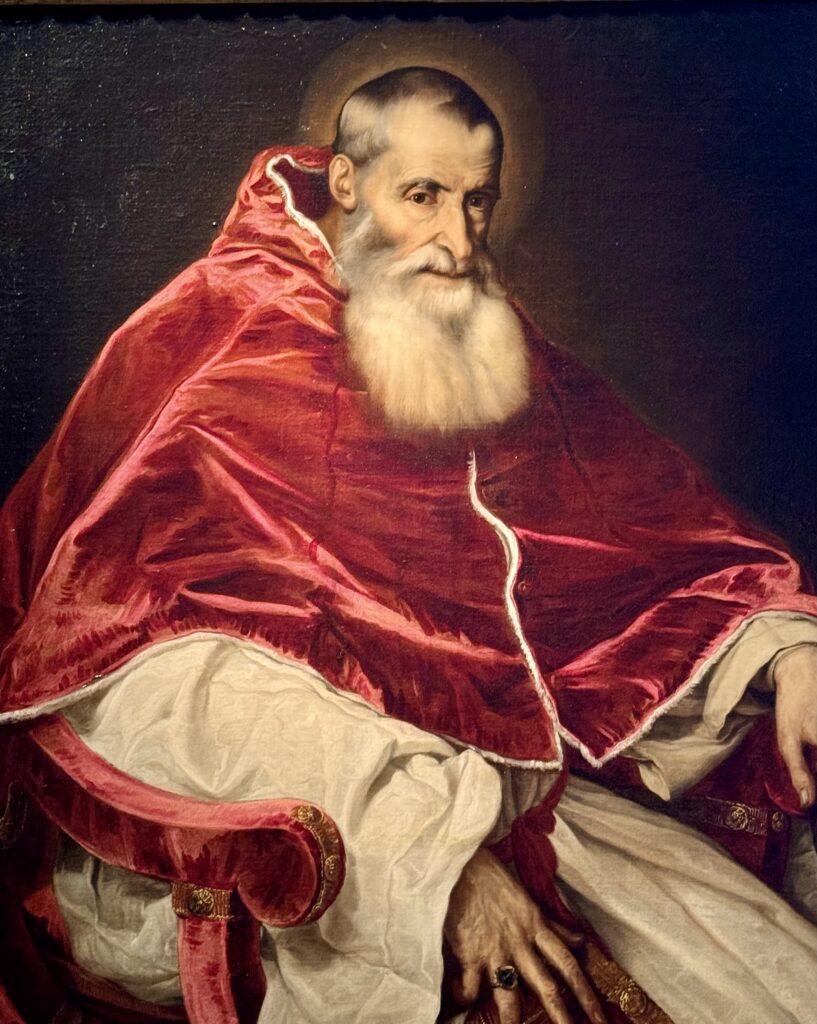
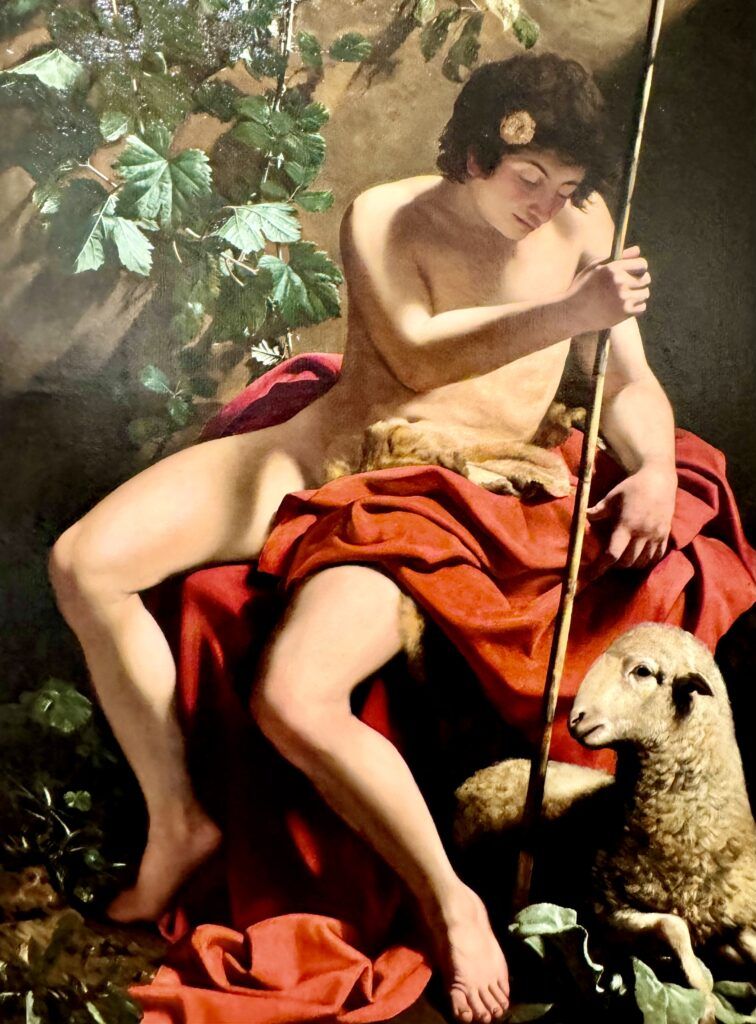
Two attached rooms display more masterpieces, including artworks by Caravaggio, Zurburan, Van Dyke, Titian, Raphael, Velazquez, and Rubens.
You can also visit the Treasury. You’ll find the 10 foot high gold and silver monstrance made for Queen Isabella in the 16th century.
It once held the consecrated host. On Corpus Christi day, it’s paraded around town.
I think this is the top cathedral in Spain. Seville Cathedral may be larger. But, to my mind, this one boasts unrivaled art and artistry.
>>> Click here to pre-book a skip the line ticket for the cathedral
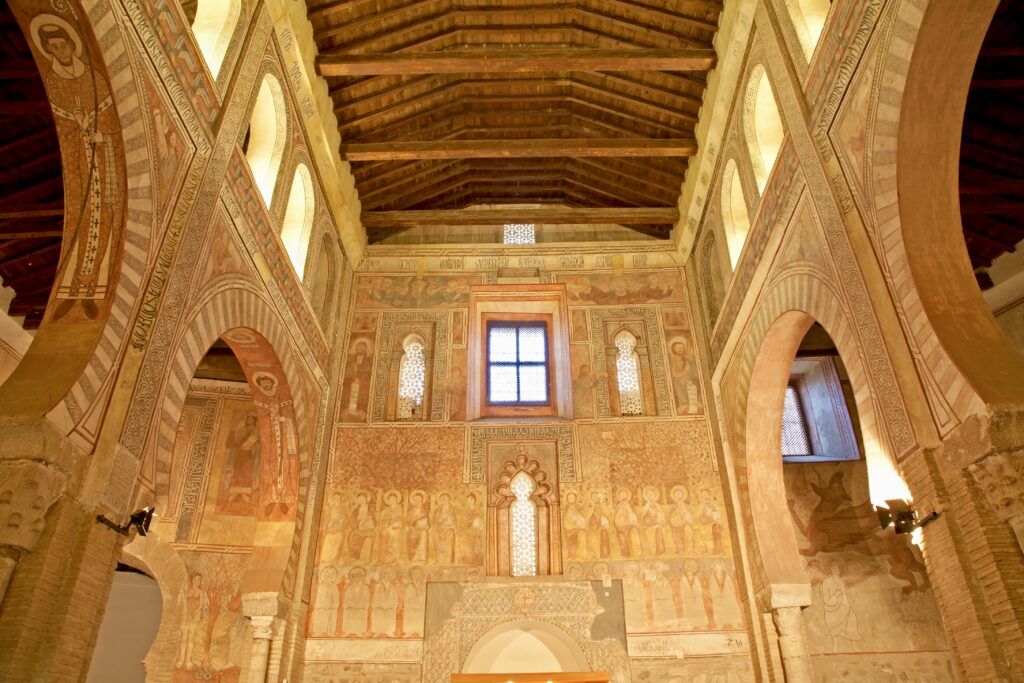
12:30: San Roman & Santo Domingo el Antiguo
San Roman is Toledo’s oldest church, featuring Romanesque architecture. It’s just a few minutes from the cathedral. It’s the most interesting church in Toledo, having kept its original 13th century structure.
Originally of Visigoth origin, San Roman served as a mosque before its reconstruction in the Mudejar (Arab) style during the 13th century.
Today, it hosts a museum showcasing Visigothic culture. Inside, you’ll encounter a unique blend of Caliphal arches, Roman columns, Visigoth capitals, and exquisite frescoes.
Next, head down the street to Santo Domingo el Antiguo. Established in 1085 by the Cistercians, it was Toledo’s first convent.
The interior boasts Neo-Classical design and houses three El Greco paintings. It’s also the final resting place of El Greco himself, with his tomb visible through a floor grill.
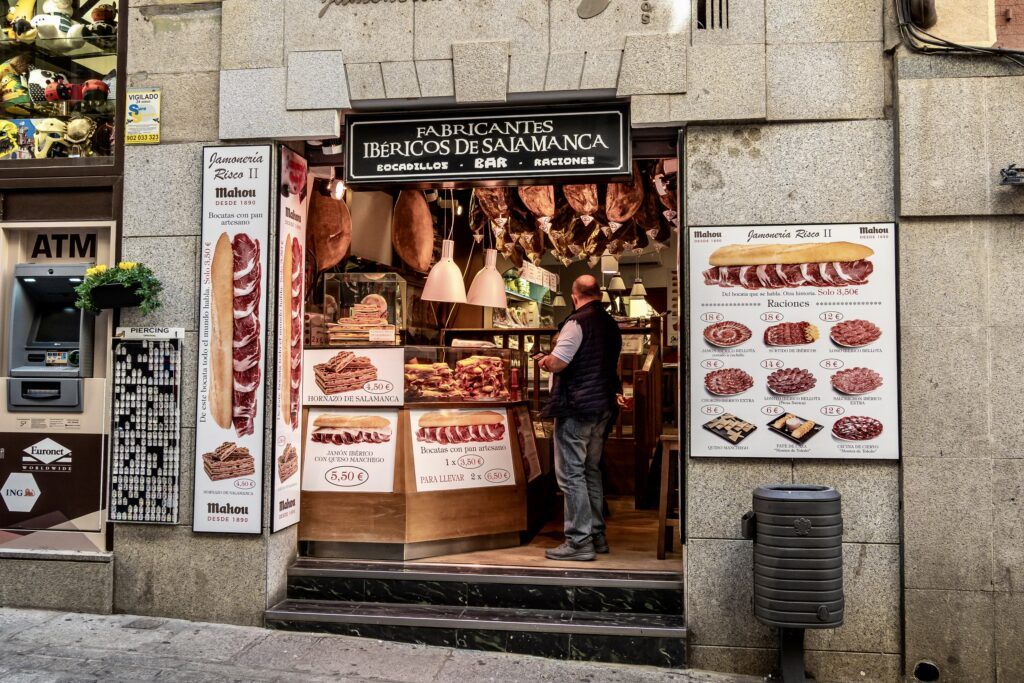
1:00 PM: Lunch in Toledo
Take a break for lunch at a local “mesón” or tavern. Toledo is known for its savory cordero (roast lamb) and carcamusas (stew).
Modern Toledo depends on tourism. So you may became jaded at the sight of so many bilingual menus. Steer into the steep cobbled streets for the best eats.
If you are in a rush you can always grab a sandwich to go, with Iberian ham or chorizo. That’s what I ended doing just to save time as I toured around.
If you have a sweet treat after lunch, I recommend sampling some marzipan. Toledo’s specialty, at Santo Tome. It’s a family business that has flourished since 1856.
They make it by combining Spanish almonds with sugar, honey, and water to make a thick paste. Once hardened, the marzipan can be sculpted into ingenious shapes.
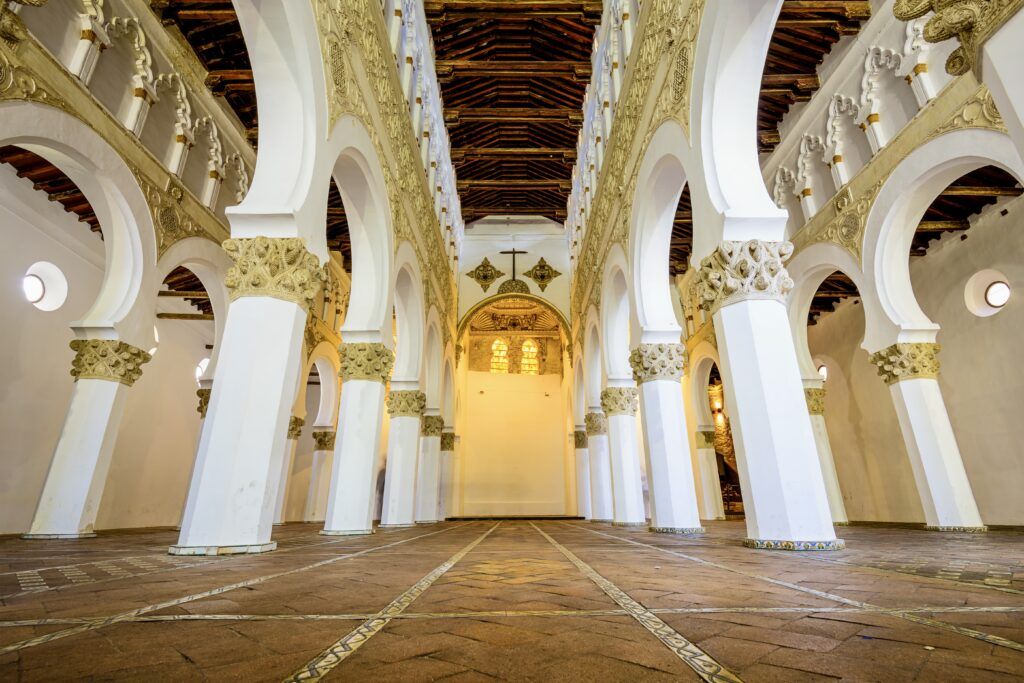
2:30 PM: Explore the Jewish Quarter
After lunch, stroll through the narrow winding streets of the Jewish Quarter, one of the best-preserved in Spain. Don’t miss the picturesque Calle del Ángel and Calle de los Reyes Católicos.
If you have time, pop into the Church of Santa María la Blanca. It was the main synagogue in the Jewish Quarter in the late 12th century and is immaculately restored.
It has a Moorish design with five naves and horseshoe arches. It reminded me somewhat of the Mezquita in Cordoba.
The other synagogue to visit is the Transito. Commissioned in the mid 14th century, it houses the Sephardic Museum. You enter through the left side door at the foot of the prayer hall.
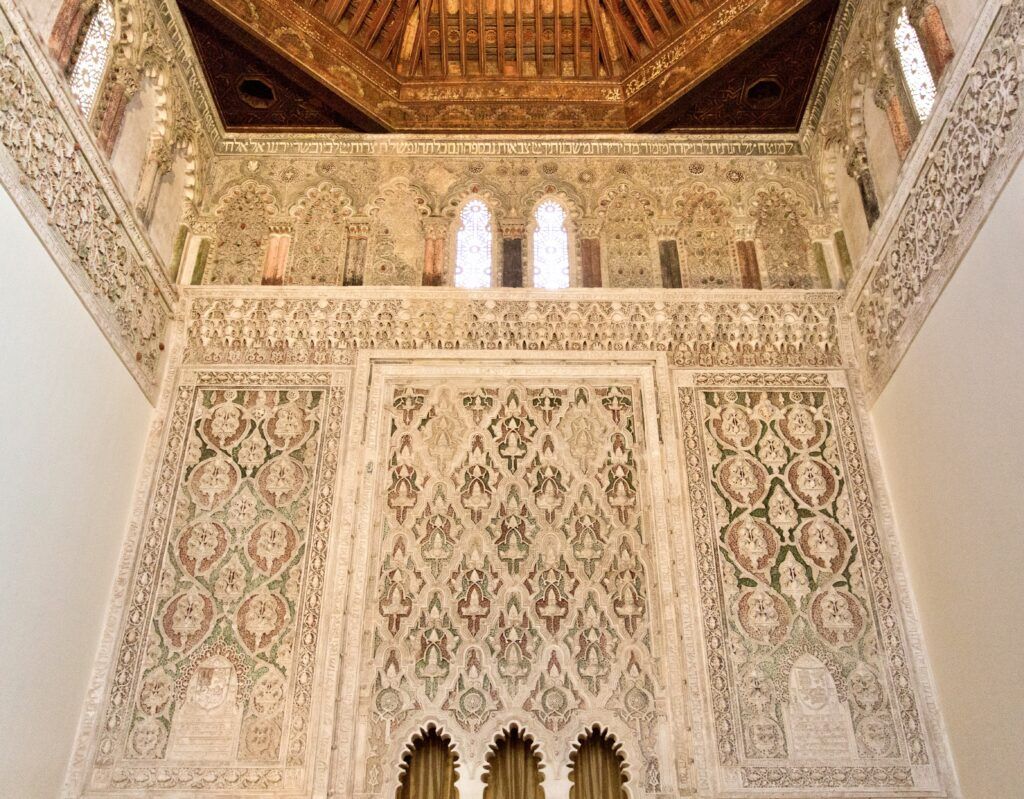
The synagogue has been completely restored and has a showstopping Mudejar main worship hall.
It’s topped with a coffered ceiling and covered in ornate stucco decorations with floral and geometric shapes and Arabic inscriptions. It may remind you of Granada’s Alhambra.
If you have time, stop into the Franciscan Monastery of San Juan de los Reyes.
It was build by the Catholic monarchs, Ferdinand and Isabella, as their funery mausoleum, though they were later buried in the Royal Chapel in Granada.
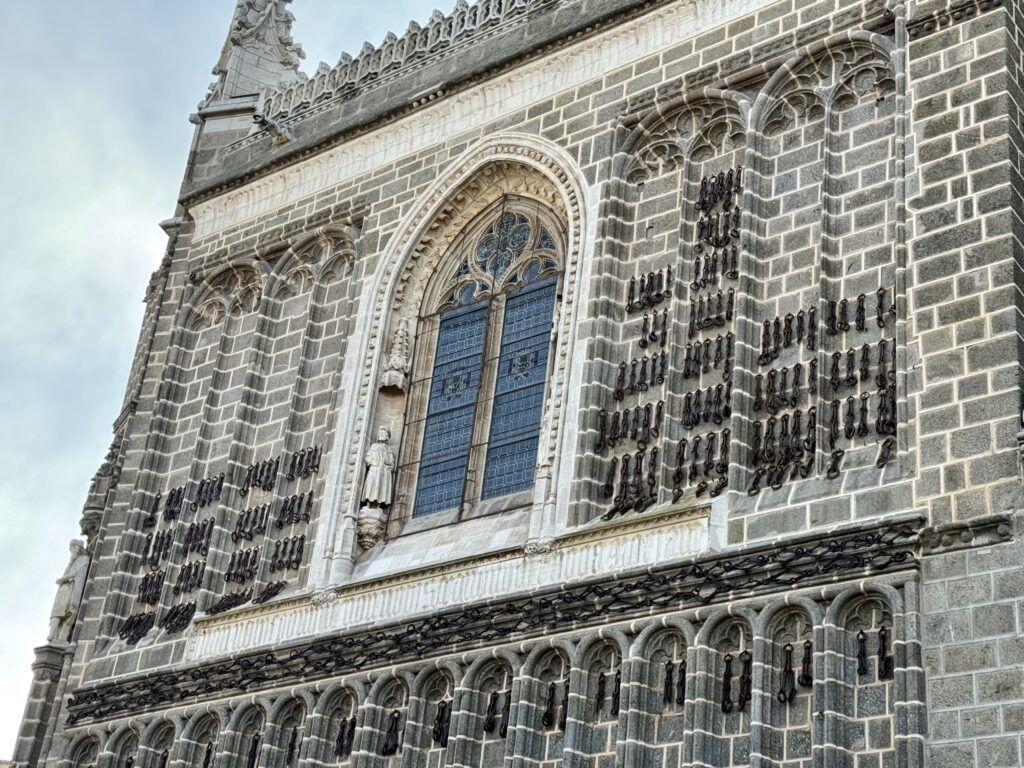
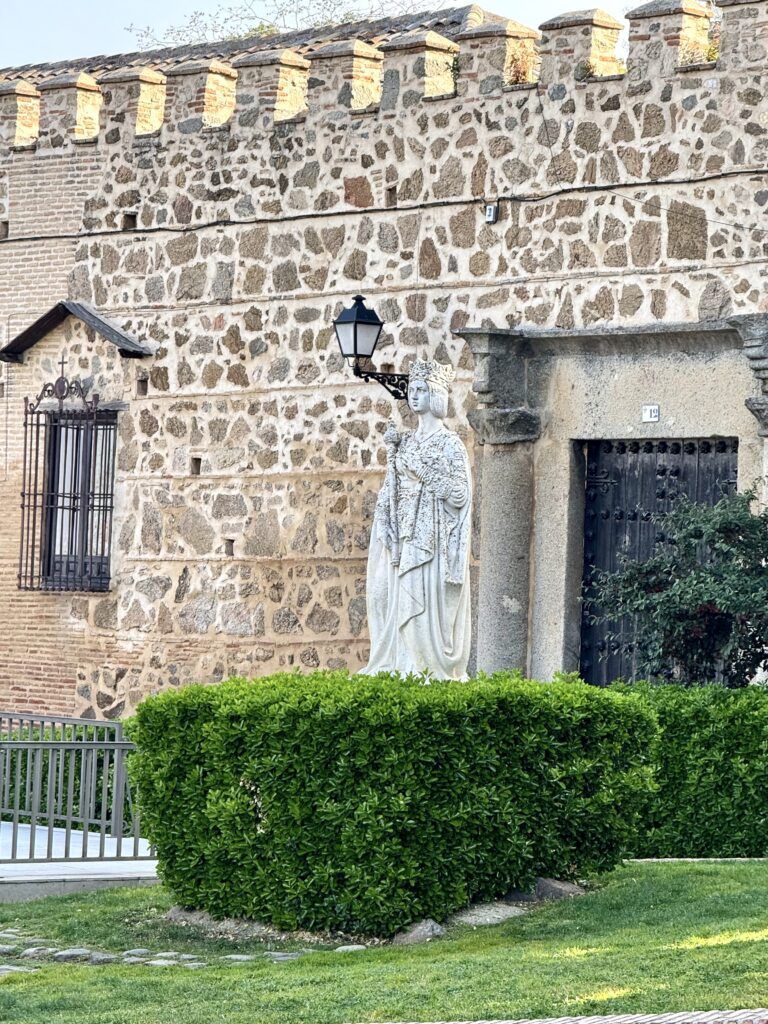
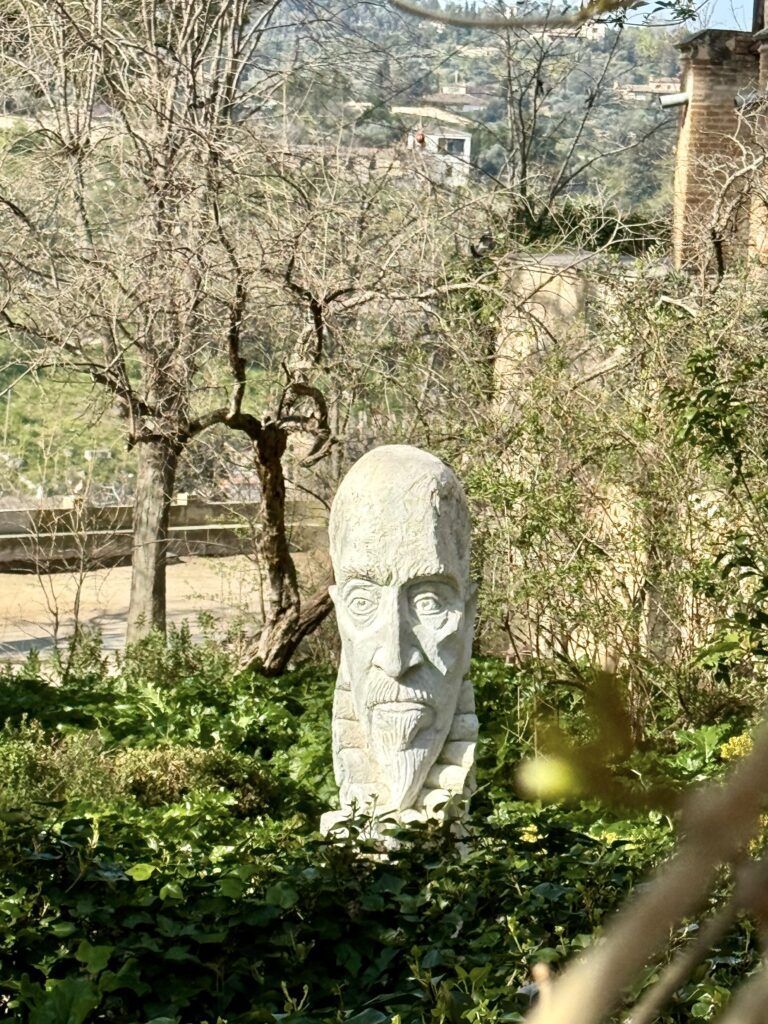
The building was constructed by Juan Gaus in the Gothic Isabelline style. it consists of a church, two cloisters, monastic quarters, courtyards, and gardens.
On the exterior, you’ll see chains hanging on the western side. They are the shackles of Christian prisoners freed by the Catholic monarchs in 1483.
The interior boats a rich stone decor, built in just 35 years. The dome is shaped like a royal crown. The most spectacular part is the upper floor and its magnificent painted Mudejar ceiling.
>>> Click here to book a walking tour of the Jewish Quarter
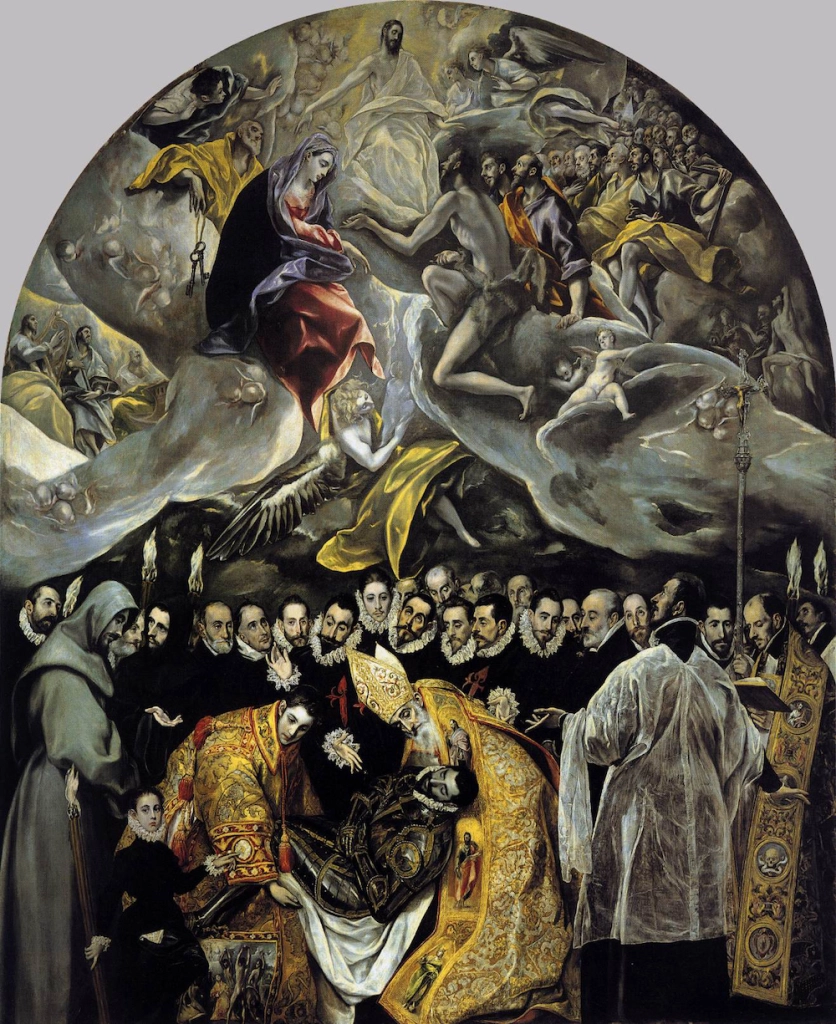
4:00 PM: Santo Tomé Church
Next, make your way to Santo Tomé Church. The church itself is a fine example of Spanish Gothic architecture and has a rich history dating back many centuries.
But what you come here to see is El Greco’s finest and most beautiful masterpiece, The Burial of the Count of Orgaz.
It was commissioned by Don Gonzalo Ruiz. He was a wealthy and influential nobleman in Toledo during the late 13th and early 14th centuries.
The painting is monumental, more than 15 feet high. It depicts a legendary miracle where St. Augustine and St. Stephen descended from heaven to assist in the burial of the count.
The painting is divided into two sections by a row of noblemen’s faces. Each one is a distinct portrait. El Greco even included portraits of himself and his 8 year old son in the painting.
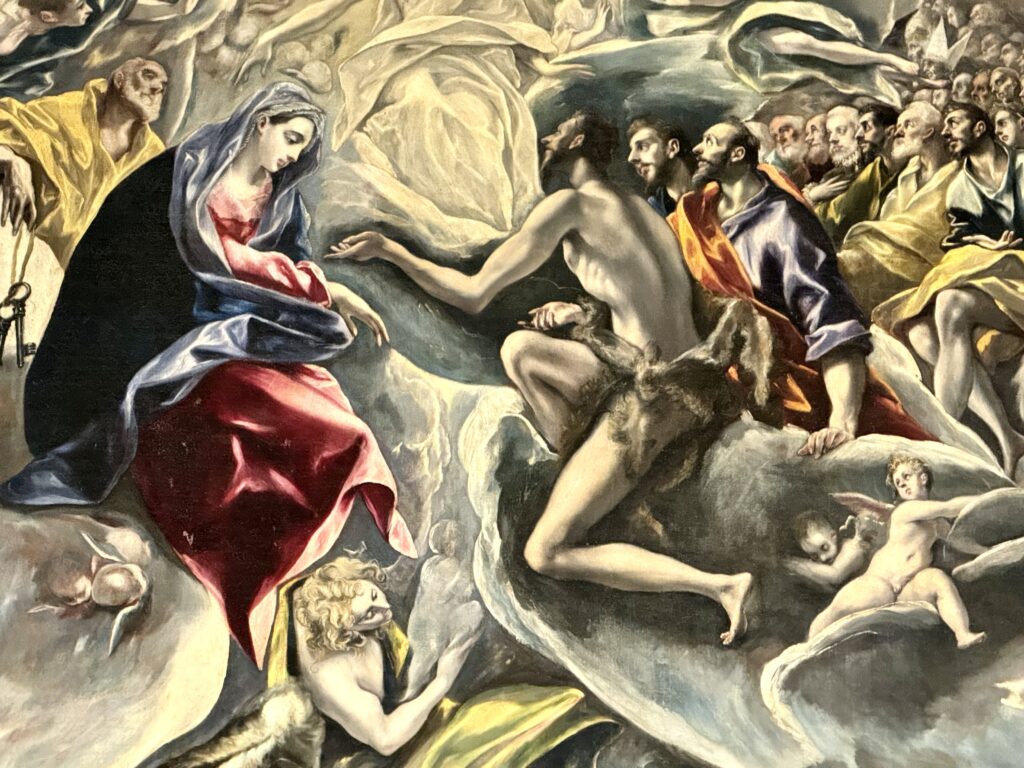
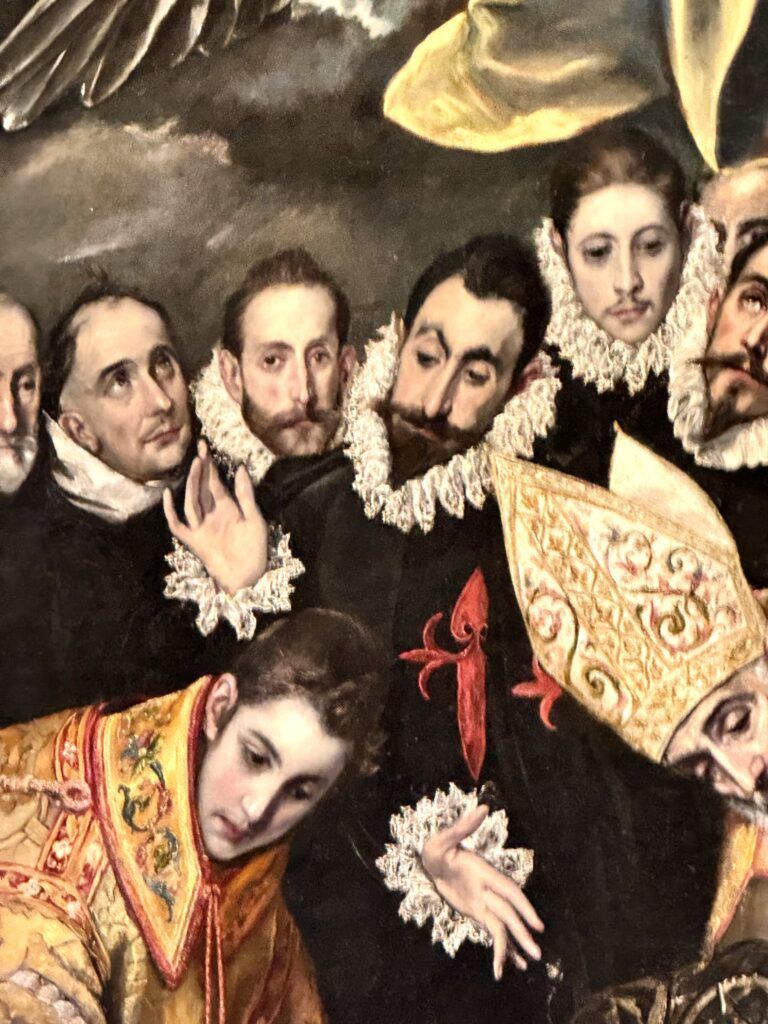
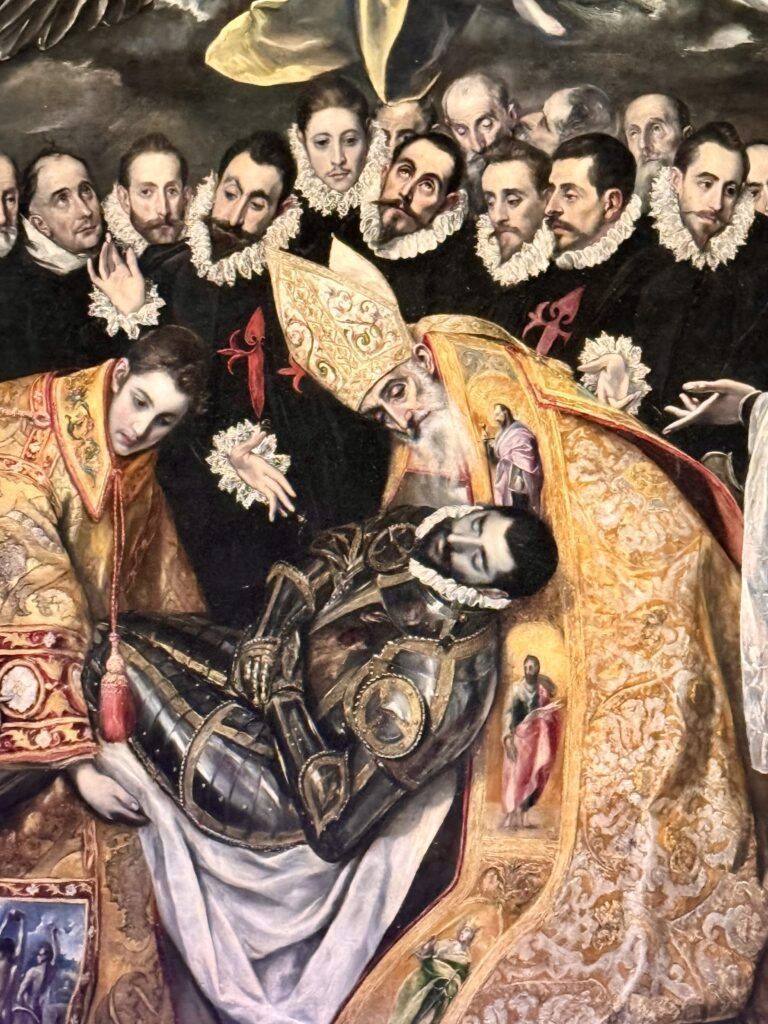
The bottom half of the painting depicts the miracle and the count’s funeral.
It’s a variant of entombment paintings you may have seen by Raphael or Titian. Two dead saints, unexpected guests, appear to lower the count’s body into the tomb.
In the top half, you see the heavenly realm and key religious figures. An angel sent to earth by God guides the count’s soul up for his judgment. He appears as an embryo the size of a baby.
The Virgin also makes an appearance, seeming to say “come with us.” Beside her, St. John the Baptist speaks to Jesus, interceding for the soul of Orgaz.
The message of the painting for 16th century Toledo citizens was clear. If you want to make it to heaven, behave like the good count.
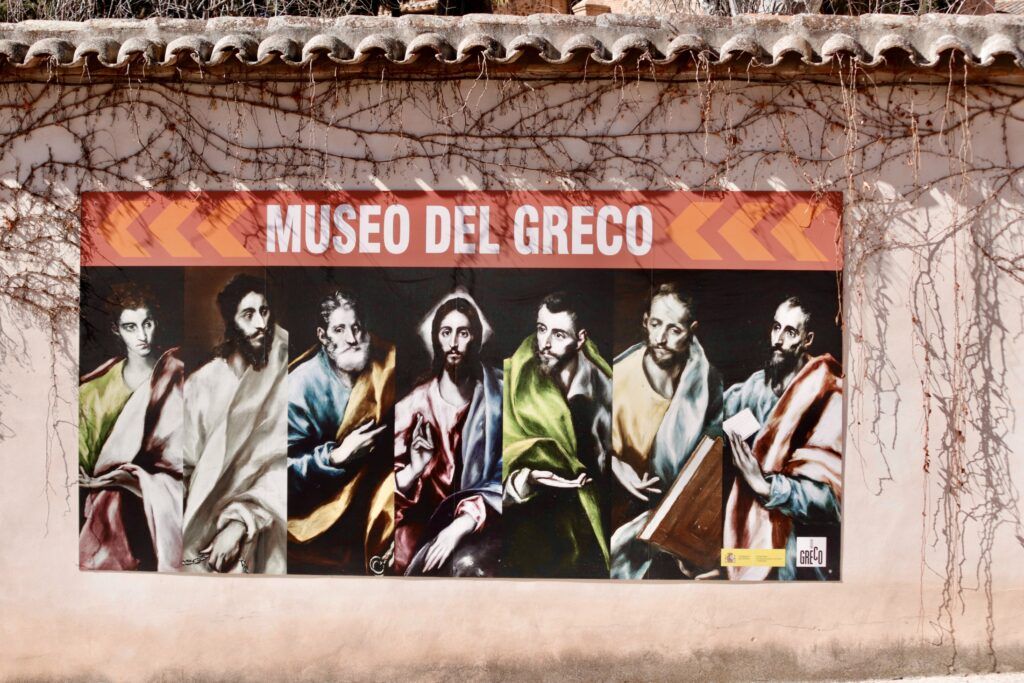
5:00 PM: El Greco Museum
Your last stop is at the El Greco Museum. El Greco was the city’s most famous resident artist. No visit to Toledo is complete with seeing his eponymous museum.
It’s the only museum dedicated to the renowned Greek painter. Its primary mission is to offer insight into El Greco’s artistic contributions and the profound influence his works and persona had on early 17th century Toledo.
The museum is housed in a lovely Spanish casa. It was founded by the second Marquis de la Vega-Inclán, a great promotor of Spanish art.
He thought, or so the story goes, that he was buying El Greco’s home. But it wasn’t.
Nonetheless, he lovingly renovated the 14th century mansion, in period authenticity, to house the collection of the Council of Toledo.
The museum boasts an extensive collection of El Greco’s masterpieces. They all seem to ripple and writhe as if on the verge of ascension, with elongated bodies and elegant hand gestures.
You’ll find notable works like View and Plan of Toledo (a variant of which resides in the Prado Museum), Tears of St. Peter, and St. Bernadine of Siena.
The View is an extraordinary piece, giving you a panoramic view of Toledo at the time. The city is celebrated in all its excellence and glory as Spain’s oldest city.
The painting is rendered in El Greco’s later style, which featured looser brushstrokes and a more abstract composition. The buildings are reduced to simple geometric forms, which likely influenced the French Post-Impressionist Paul Cezanne.
The museum also features a meticulously curated series of portraits known as the Apostolate series from 1607. Christ is in the center surrounded by 6 apostles on each side.
Only 3 of the 13 paintings are finished. The focus, and where you’ll see El Greco’s highest quality work, is on the hands and faces of the apostles. Legend holds that El Greco used mental patients from an asylum as models, and indeed some of them appear malnourished.
There are another 100+ paintings by Spanish masters from the 16th and 17th centuries, many of them from El Greco’s workshop.
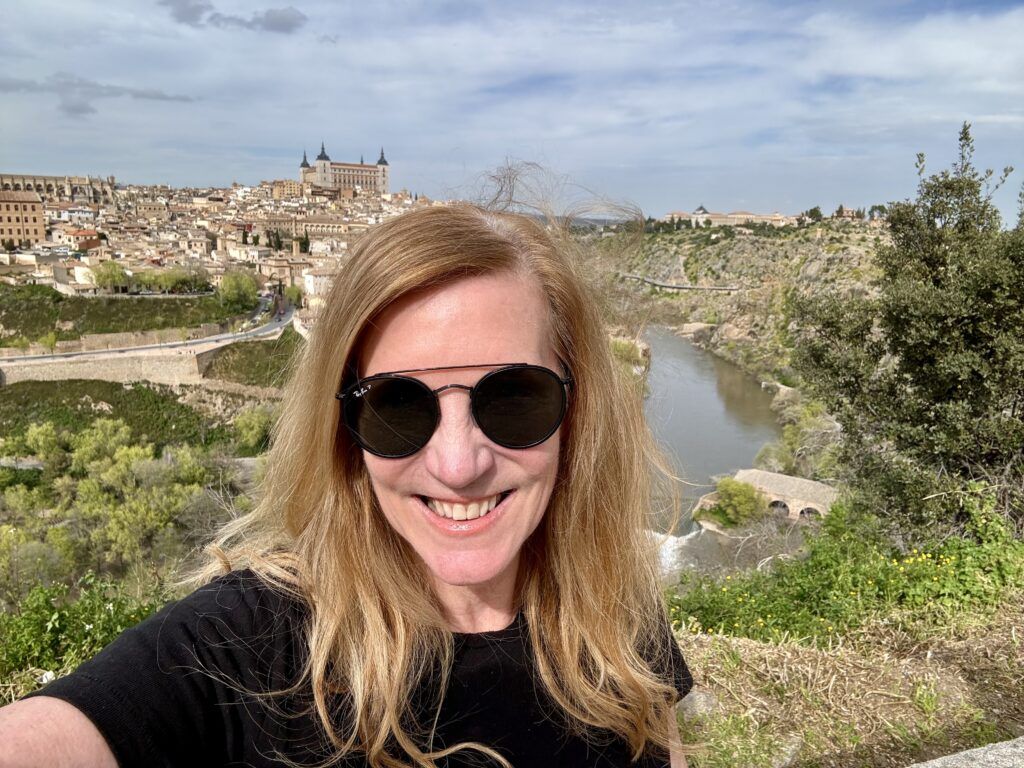
6:30 PM: Toledo’s Mirador del Valle
As the sun begins to set, head to the Mirador del Valle. It’s a viewpoint that offers the classic panoramic view of the city. It’s a great spot for photographs and I highly recommend going.
It’s about a 30-40 minute walk from the city center. Head towards the direction of the Alcázar of Toledo. As you approach the Alcázar, continue uphill along the road called Paseo de la Rosa to the mirador.
You can also take a taxi or drive there. Local buses leave from Zocodover Square and the Hop On Hop Off tourist bus stops there as well. If you are on a guided day tour from Madrid, you bus will likely stop there.
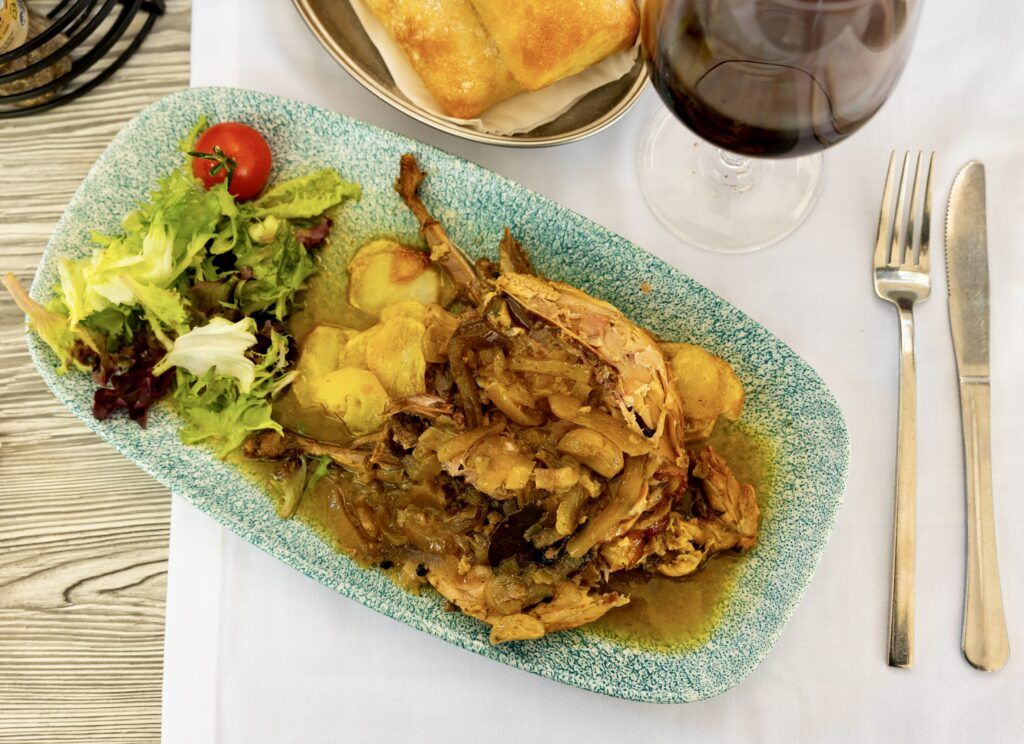
7:30 PM: Dinner in Toledo
For your final meal in Toledo, dine at one of the city’s many fine restaurants.
Try local dishes like the prized perdiz a la toledana (a long tailed partridge) and have marzipan for dessert. Check out Adolfo or Venta de Aires Restaurant for good eats.
Toledo is especially magical at night. If you have any time, take a stroll around the city when everything is illuminated. The last train back to Madrid usually departs around 10:30 or 11:00 pm.
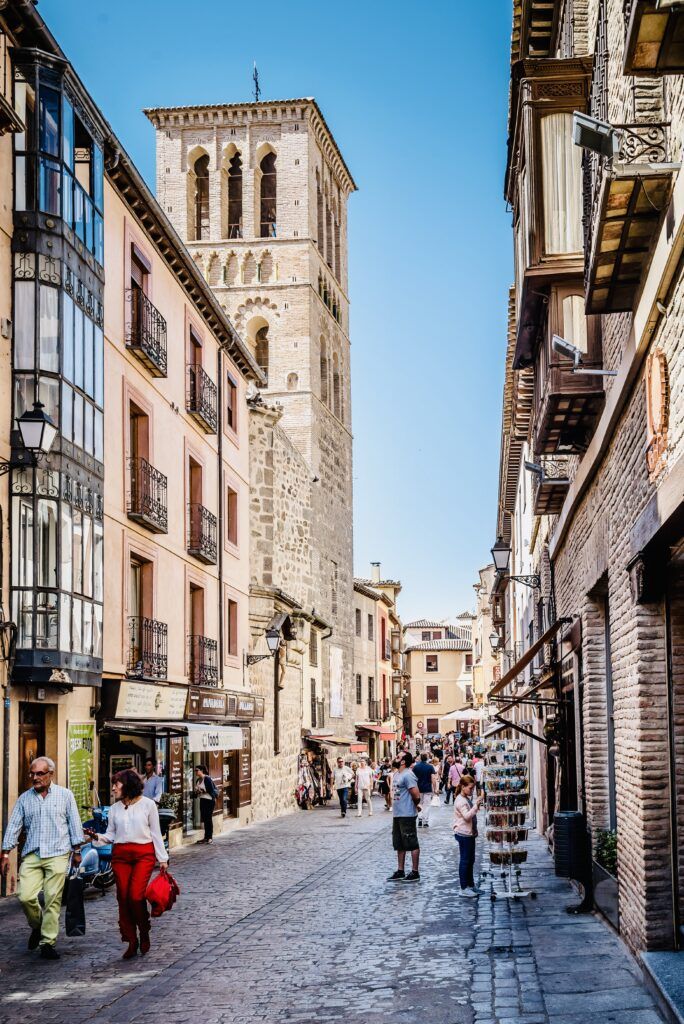
Practical Tips For One Day Trip In Toledo
Here are some must know tips for day tripping to Toledo:
1. How To Get To Toledo
Toledo is easily accessible from Madrid by high-speed train (AVE) or bus. Purchase tickets in advance, especially during peak tourist seasons.
You’ll then have a bit of a steep climb to get to the historic center. It’s a 30 minute walk, so you should probably hop in a cab.
Naturally, you can also get to Toledo on a guided day tour from Madrid. You can also book a tour that takes you to both Toledo and Segovia. To make things really easy, this private guided tour picks you up at the train station and takes you on a panoramic taxi tour of the city.
If you’re driving to Toledo, you’ll want to park your car in one of the designated parking areas outside the city’s historic center. Don’t drive into the historic center!
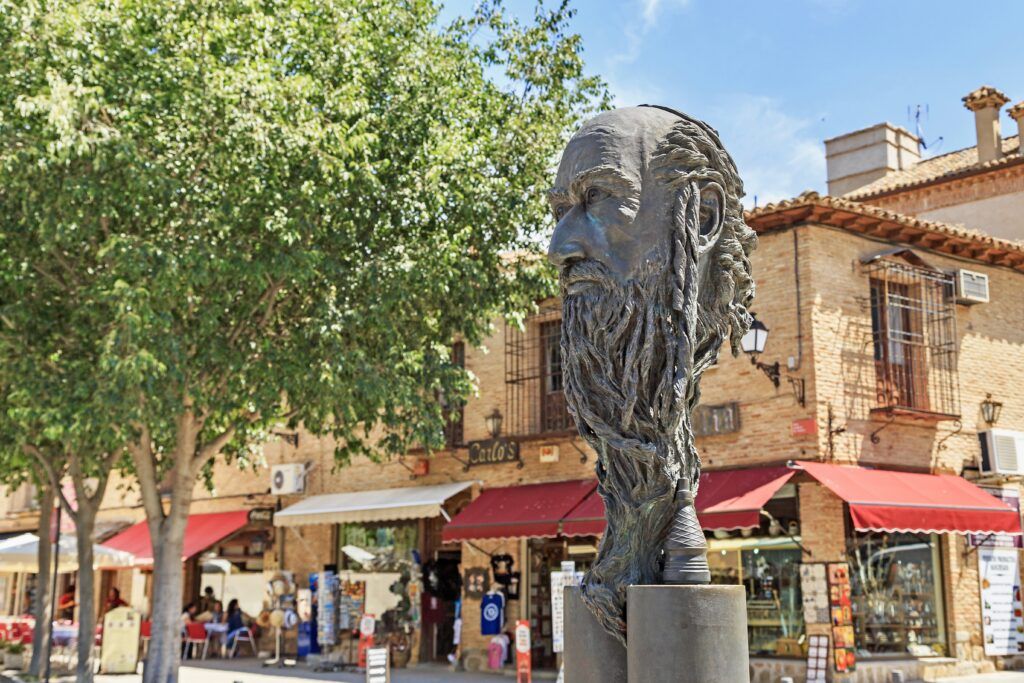
You can find spots in Parking Safont (north), Parking Cigarrales (south), or Parking Alcázar (near the Alcazar). A car has the advantage of allowing you to drive to the different viewpoints.
2. How To Get Around Toledo
Toledo is fairly small and walkable. You can get to most attractions on foot, if you’re inclined to walk. Be forewarned that it’s hilly and you’ll be walking up and down.
You can also take the Hop On Hop Off tourist bus.
3. Tickets:
Consider buying the Toledo Bracelet Card, which gives you access to multiple attractions, saving you time and money.
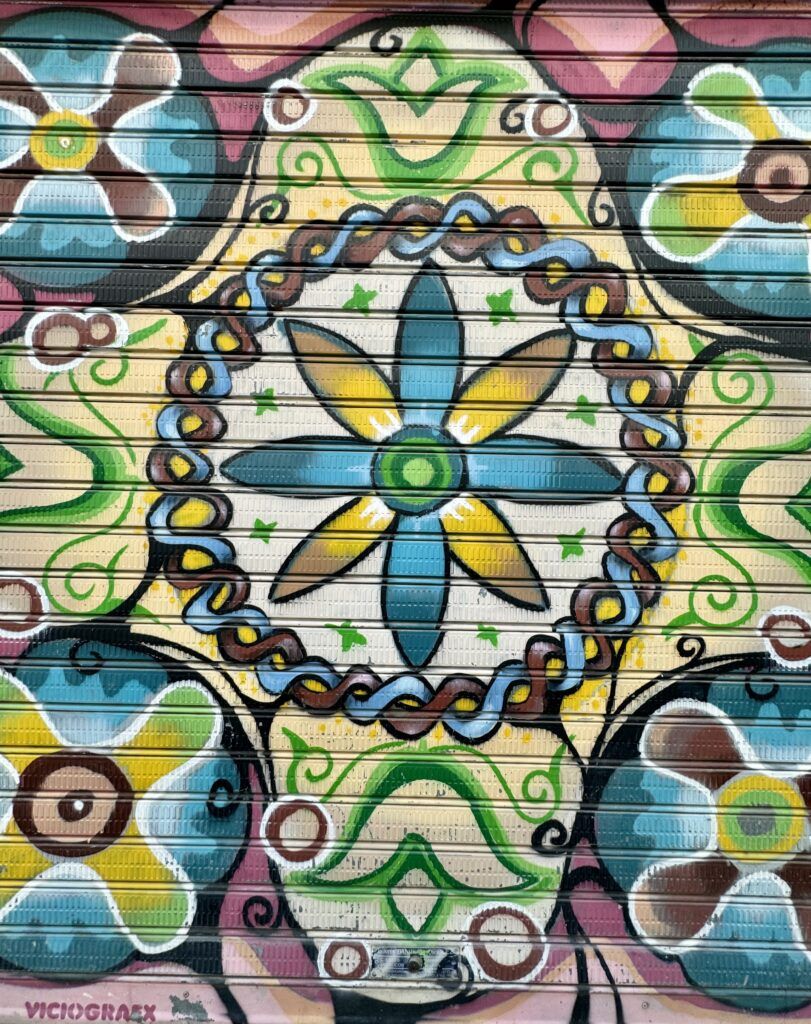
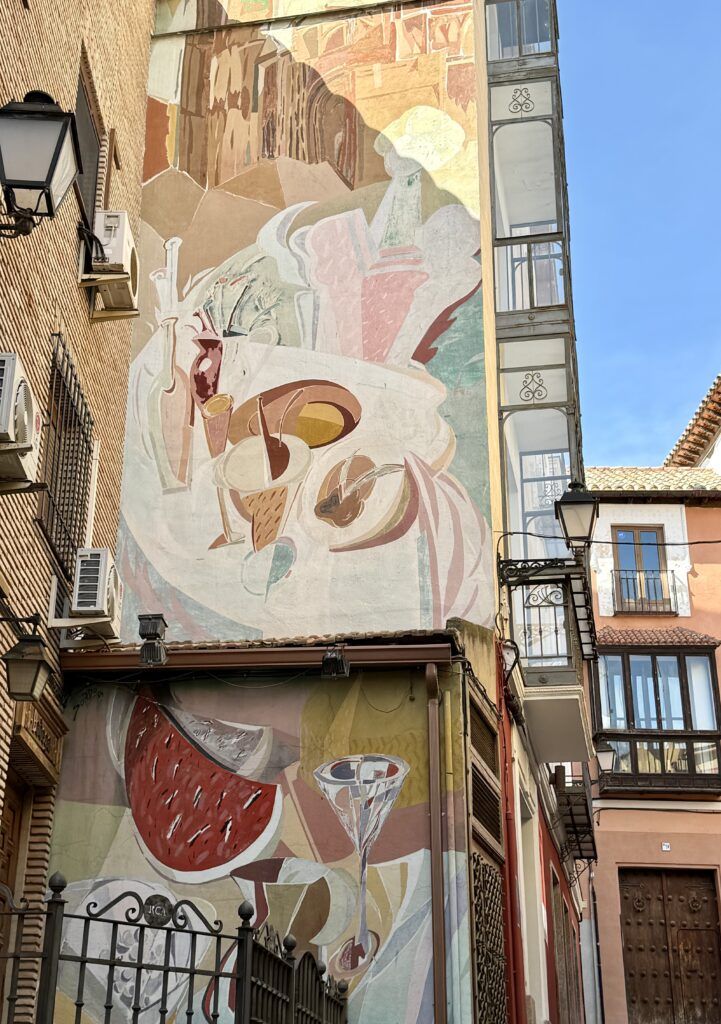
4. Where To Stay In Toledo
Considering staying overnight in Toledo? If so, you have a range of hotel options.
The Eugenia De Montijo, Autograph Collection is a gorgeous luxury hotel with regal Renaissance decor. It’s only 600+ feet from the cathedral, so well situated for sightseeing.
The Hotel del Cardenal is right next to the Gate of Alfonso VI, once the main entrance into Toledo. it’s literally built in the city wall. It’s quite reasonable, especially given the fountains, gardens, and patios it has on offer.
Parador de Toledo sits on a hill with an ideal vantage point over the city. It has a swimming pool and luxury amenities.
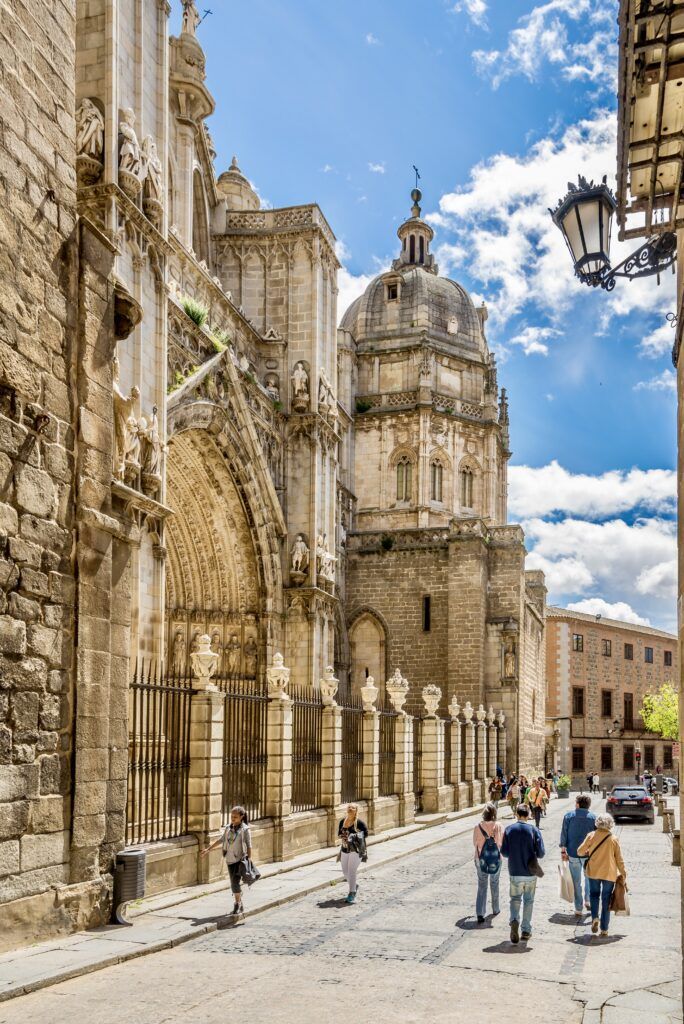
5. Pro Tips:
Many shops and restaurants close for siesta, usually from around 2:00 pm to 5:00 pm.
You’ll also want to wear comfortable shoes for hiking up and down the steep hills and tromping on cobblestones.
6. Is One Day In Toledo Enough?
One day in Toledo is enough time to see the highlights, but not enough to see everything. But you can check off the top attractions and decide what you want to come back to see.
I hope you’ve enjoyed my one day in Toledo itinerary and day trip guide. You may enjoy these other Spain travel guides and resources:
- 10-14 days in Spain itinerary
- 1 day itinerary for Barcelona
- 3 day itinerary for Barcelona
- 40+ Landmarks in Barcelona
- 33 secret towns in Spain
- 10 day itinerary for Andalusia
- Most Beautiful Towns in Andalusia
- 1 day itinerary for Seville
- 3 day itinerary for Seville
- 2 day itinerary for Madrid
- 2 day Itinerary for Bilbao
If you’d like to spend one day in Toledo, pin it for later.

